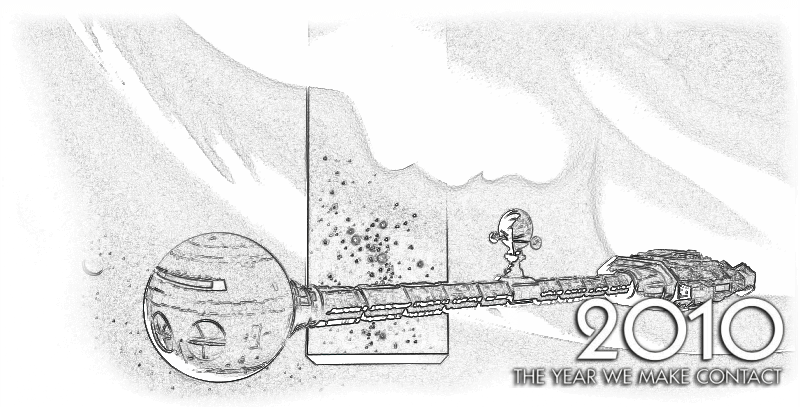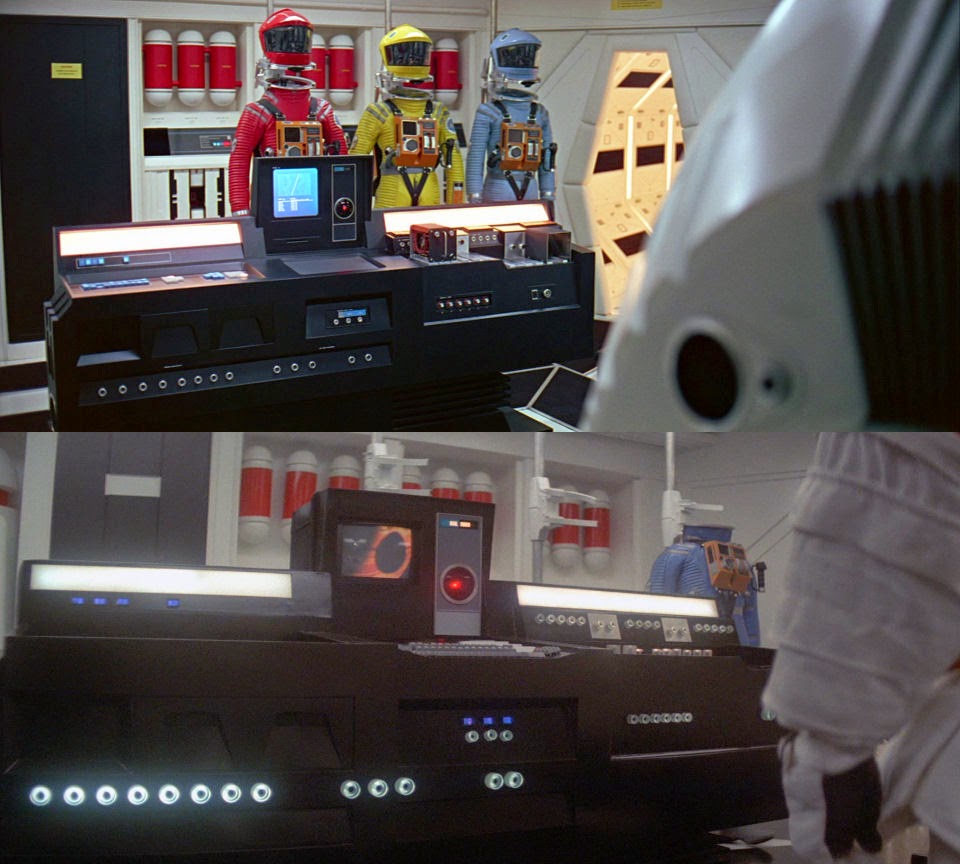After Clarke finished his Odyssey Sequence tetralogy, it had become clear the monolith was more than a a mere black block.
During the production of 2010, author Clarke disclosed to director Peter Hyams what he thought the monolith was: nothing less than "the Cosmic equivalent of a Swiss army knife." Thusly the monolith can be best described as a meta-machine; the ultimate gadget that will tailor itself according to whatever task it must bring about.
The slab performs many ostensibly unthinkable feats: it self-replicates ceaselessly upon demand (in 2010), it blots out the sun when necessity dictates (in 2061), it annihilates life at its discretion (in 3001), it bends space-time when needed (anytime, anywhere), and perhaps most conspicuously acts as a travelling agent to the stars.
Porta Exotica
The monolith is explicitly mentioned in 2001: A Space Odyssey as a "Star Gate". In physicist parlance the monolith would be called a wormhole.
 |
| A wormhole allows a photon to take a shortcut. |
Previously scientists were convinced that bridges - if they are spontaneously formed - will only exist for extremely short moments before collapsing upon themselves. As a matter of fact, Einstein's theory of relativity predicts such bridges must exist every/somewhere in the Universe, spontaneously popping in and out of existence. However, with the introduction of so called 'exotic matter' - theoretical matter with negative energy - it could excathedra be possible to maintain such a bridge indefinitely. If the exotic matter could be controlled as normal matter with positive energy, an Einstein-Rosen bridge could be maintained by "holding it open," effectively creating a portal allowing for seemingly faster-than-light (FTL) travel. The traveling would actually not be faster than light, but would only seem so due to the shortcut properties of the bridge.
Exotic matter is perhaps not as exotic as we assume. Negative energy can be produced in laboratory conditions by the Casimir Effect, where two plates are placed next to each other, nanometers apart. Vacuum is not "empty" (in the vernacular nomenclature), but full of quantum fluctuations, an immense amount of untappable energy. (The energy amount is truly enormous, conservative evaluations estimate the amount to be 1x10^42 Joules per cubic meter, which translates to one million trillion trillion trillion Joules, or the energy needed to reduce roughly 10 billion Earths to clouds of dust orbiting the Sun.) The electromagnetic waves caused by these fluctuations will not "fit" between the plates - their wavelength is "longer" than the distance between the plates - and thus the 'artificial vacuum' between the plates will contain less total energy than 'normal vacuum', in other words negative energy.
Thus the monolith might be constructed by exotic matter, explaining why it is "impenetrable" to all human attempts at cracking it. There exists one crux, however.
 |
| Linked black holes. |
There is one problem with the Einstein-Rosen bridges, however. While Dave Bowman might enter the wormhole from a place located in, say, another galaxy, and Frank Poole would enter the wormhole at the monolith orbiting Jupiter, they would both meet in the middle, but they would both be annihilated at a then-present singularity. In fact, any matter traversing the so called ultrastatic wormhole always results in a black hole.
What's even worse, the singularity - which is "shared" between the two black holes - will almost invariably spontaneously split into the two separate black holes at the point of the gravity wells in the space-time fabric. And yes, the split happens at a speed faster than light. It's better if you don't think about it too much. Any any case, not a pleasant option for intergalactic travel.
I don't think any insurance would cover it, either.
Sailing with Scharnhorst
A further anomality that can allow faster than light travel is a peculiar effect predicted by Klaus Scharnhorst; a photon can - in a very special set of circumstances - travel faster than light. It is not much faster, in fact it is 1 part in 10^36, but it is there.
 |
| Bending of space-time, courtesy of Douglas Trumbull. |
Regardless of how much faster the photon might travel, any such effect can be multiplied indefinitely, setting no theoretical upper speed limit on relocation.
The effect is in fact poorly understood, but one of the possible explanations is that the photons really never travel faster than C, the speed of light - exactly as expected, and in no violation of causality - but the space "around" them is undefined, or rather defined as "moving". The reference system in which the photon is travelling is thus moving, or more precisely bent. In such a case, any and all movement within the system will still clearly be within the confines of the Cosmic speed limit of C, but that it is the fracturing of space-time itself within the system that allows for the seemingly impossible to occur.
The effect has been further examined by Miguel Alcubierre, and his Alcubierre metric relies on the creation of negative mass "bending" the space fabric in front of the point being moved. This allows the moving point to travel at the speed of C within a set of space with is itself "moving" while being bent by negative mass.
So, what does superluminal (faster than light, or FTL) speeds have to do with wormholes?
It's Full of Tachyons
Well, in 1967 Gerald Feinberg presented a 'tachyon hypothesis' in The Physical Review, essentially stating that superluminal speeds are not just possible, but probable, and most probably (bad pun intended) essential. Feinberg did concede that to bring any particle to the speed of light would give that very particle infinite kinetic energy, i.e. more energy than the combined energy of the Universe, but he proceeded to calmly offer undeniable evidence that the speed of light is in fact the only impossible speed. Superluminal speeds, i.e. faster than light are prefectly acceptable. The proposed superluminal tachyon particles are forever divorced from the subluminal Universe by the unbreakable "wall of light."
 |
| A block of negative matter, no less. |
Now, going further down the rabbit produces some rather peculiar effects. Regardless of this permanent divorce, the nature of said tachyons put great strain on causality: a tachyon ray would hit it's target before it has even been fired, triggered tachyon relays send signals to their own past only if they will not have received a signal from their own future self, and so on. This means superluminal tachyon scalar fields can never relay subluminal signals. However, tachyon condensate - the spontaneous shedding of particles in order to lower energy - could be controlled by the already mentioned exotic matter, which as you recall is matter with negative energy. Hereby the shedded particles, the quanta of the scalar field - free bosons - seemingly remain fixed in a non-movable time frame, producing the perhaps somewhat surprising effect known as instantaneous signal transfer to any point in the Universe. Signal transfer is, of course, just a fancy word we feel compelled to use when we really mean 'traveling'. In science fiction this is also known as teleportation.
The monolith is many things. Some are complex. Some even more so. Out of all things it seems to be, perhaps being a star gate is the simplest.
The other things not so much.
Images copyright ©1968 MGM, ©2011 PBS, ©2013 ShutterStock.






